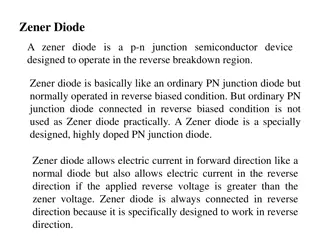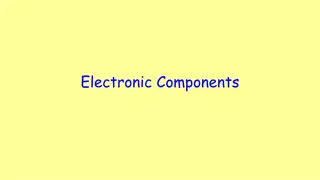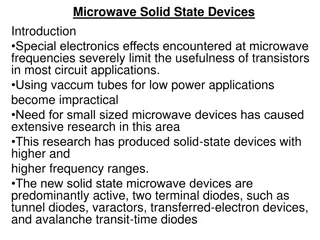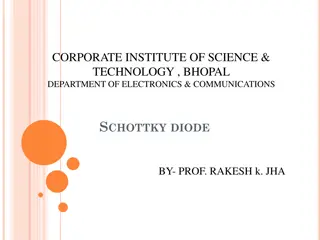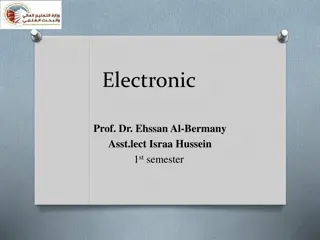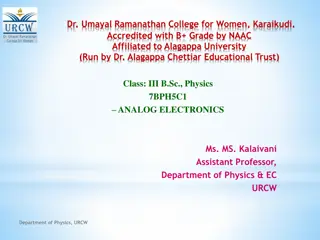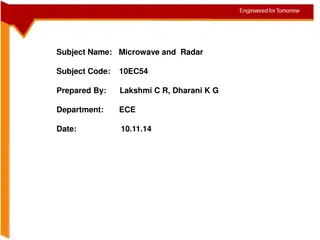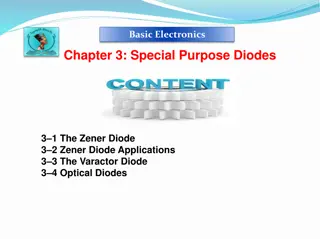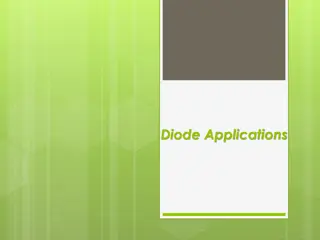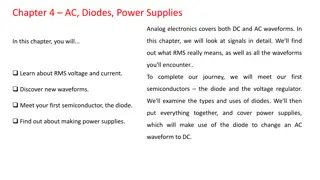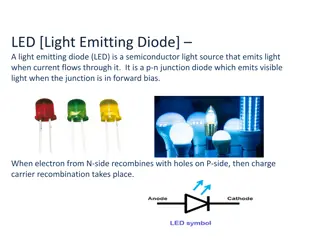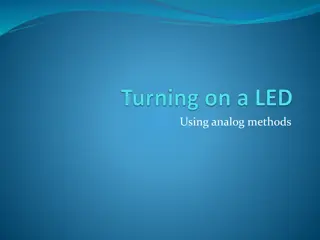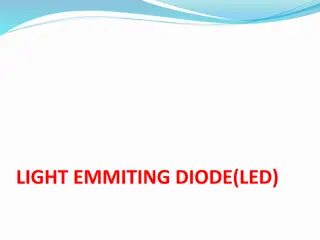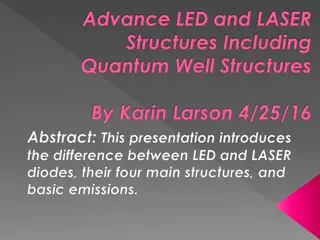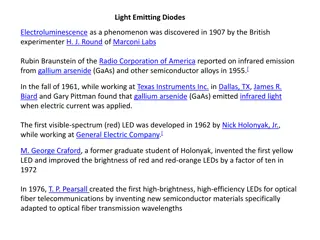Understanding Light Emitting Diodes (LEDs)
Light Emitting Diodes (LEDs) are semiconductor devices that convert electrical energy into visible or invisible light. They are constructed using gallium, phosphorus, and arsenic materials instead of silicon or germanium. The recombination process in forward bias condition is crucial for the operation of LEDs, where free electrons and holes recombine to emit light. The symbols of LEDs indicate light emission, and they are available in various colors such as orange, yellow, green, and red. LEDs have become the most widely used diodes due to their efficiency in converting energy into light.
Download Presentation

Please find below an Image/Link to download the presentation.
The content on the website is provided AS IS for your information and personal use only. It may not be sold, licensed, or shared on other websites without obtaining consent from the author. Download presentation by click this link. If you encounter any issues during the download, it is possible that the publisher has removed the file from their server.
E N D
Presentation Transcript
Light Emitting Diode (LED) (LED)
Light Emitting Diode (LED) Light Emitting Diodes (LEDs) are the most widely used semiconductor diodes among all the different types of diodes available today. They convert electrical energy into light, which is either: - visible light - or invisible infrared light (The LEDs which emit invisible infrared light are used for remote controls).
The construction of LED is similar to the normal p-n junction diode except that gallium, phosphorus and arsenic materials are used for construction instead of silicon or germanium materials. In normal p-n junction diodes, silicon is most widely used because it is : (1) Less sensitive to the temperature. (2) It allows electric current efficiently without any damage. In some cases, germanium is used for constructing diodes. However, silicon or germanium diodes do not emit energy in the form of light. Instead, they emit energy in the form of heat. Thus, silicon or germanium is not used for constructing LEDs.
Light emitting diode (LED) symbol The symbol of LED is similar to the normal p-n junction diode except that it contains arrows pointing away from the diode indicating that light is being emitted by the diode. LEDs are available in different colors. The most common colors of LEDs are orange, yellow, green and red. The schematic symbol of LED does not represent the color of light. Hence, it is not possible to identify the color of LED by seeing its symbol.
Light Operation Emitting Diode (LED) In light emitting diodes (LED), light is produced due to RECOMBINATION PROCESS, this type of diode works only in forward bias condition. When (LED) is forward biased, the free electrons from n-side and the holes from p-side are pushed towards the junction.
When free electrons reach the depletion region, some of the free electrons recombine with the holes in the positive ions. In the similar way, holes from p-side recombine with electrons in the depletion region. Because of the recombination of free electrons and holes in the depletion region, the width of depletion region decreases. As a result, more charge carriers will cross the p-n junction. Some of the charge carriers from p-side and n-side will cross the p-n junction before they recombine in the depletion region. Therefore, some free electrons from n-type semiconductor cross the p-n junction and recombines with holes in p-type semiconductor. In the similar way, holes from p-type semiconductor cross the p-n junction and recombines with free electrons in the n-type semiconductor.
Thus, recombination takes place in depletion region as well as in p-type and n-type semiconductor. The free electrons in the conduction band releases energy in the form of light before they recombine with holes in the valence band. In silicon and germanium diodes, most of the energy is released in the form of heat and emitted light is too small. However, in materials like gallium arsenide and gallium phosphate the emitted photons have sufficient energy to produce intense visible light.
Process of Emitting light in LED When external voltage is applied to the valence electrons, they gain sufficient energy and break the bonding with the parent atoms and become free electrons. When the valence electron left the parent atom, they leave an empty space in the valence shell at which valence electron left. This empty space in the valence shell is called a hole.
The energy level of free electrons in the conduction band is high when compared to the energy level of holes in the valence band. Therefore, free electrons in the conduction band need to lose energy (in the form of light) in order to recombine with the holes in the valence band. Each recombination of charge carrier will emit some light energy. The intensity of emitted light is depends on the forbidden gap or energy gap between conduction band and valence band. The semiconductor materials with large forbidden gap emit high intensity light whereas the semiconductor materials with small forbidden gap emit low intensity light. In other words, the brightness of the emitted light is depends on the material used for constructing LED and forward current flow through the LED.
In light emitting diodes, light is produced due to recombination process. Recombination of charge carriers takes place only under forward bias condition. Hence, LEDs operate only in forward bias condition. When light emitting diode is reverse biased, the free electrons (majority carriers) from n-side and holes (majority carriers) from p-side moves away from the junction. As a result, the width of depletion region increases and no recombination of charge carriers occur. Thus, no light is produced. If the reverse bias voltage applied to the LED is highly increased, the device may also be damaged.
LED construction The method used to construct LED is to semiconductor layers on the substrate. These three layers are n-type semiconductor, p-type semiconductor and active region (depletion region), which is present in between the n-type and p-type semiconductor layers. deposit three In LED, most of the charge carriers recombine at active region. Therefore, most of the light is emitted by this region
Biasing of LED The safe forward voltage a rating of most LEDs is from 1V to 3 V and forward current rating is from 100 mA to 200 mA. If the voltage applied to LED is in between 1V to 3V, LED works perfectly because the current flow for the applied voltage is in the operating range. However, if the voltage applied to LED is increased to a value greater than 3 volts, The depletion region in the LED breaks down and the electric current suddenly rises. This sudden rise in current may destroy the device.
To avoid this, we need to place a resistor (Rs) in series with the LED between voltage source (Vs) and LED. This resistor is called current limiting resistor which restricts extra current which may destroy the LED. The current flowing through the LED is mathematically written as Voltage drop is the amount of voltage wasted to overcome the depletion region barrier (which leads to electric current flow).
Output characteristics of LED The amount of output light emitted by the LED is directly proportional to the amount of forward current flowing through the LED. More the forward current, the greater is the emitted output light. The graph of forward current Vs output light is shown in the following figure.
Advantages of LED 1-It can be easily controlled by varying the current. 2- Consume low energy. 3- Very cheap and readily available. 4- Light in weight and smaller size. 5- Longer lifetime. 6- Operate very fast. 7- Can emit different colors of light 8- Do not contain toxic material like mercury which is used in fluorescent lamps.
Applications of LED 1- Calculators 2- Picture phones 3- Traffic signals 4- Digital computers 5- Microprocessors 6- Digital watches 7- Camera flashes 8- Aviation lighting


